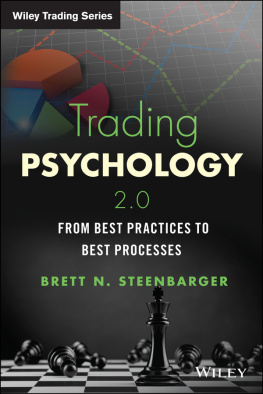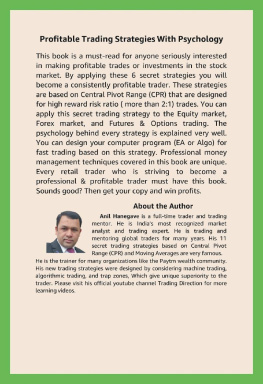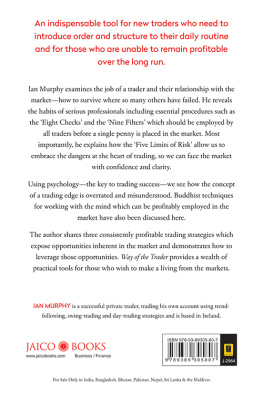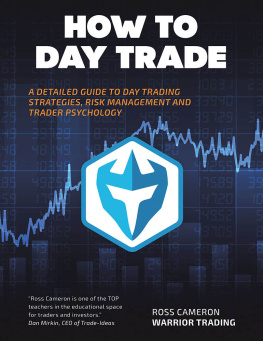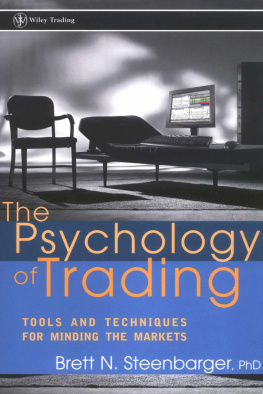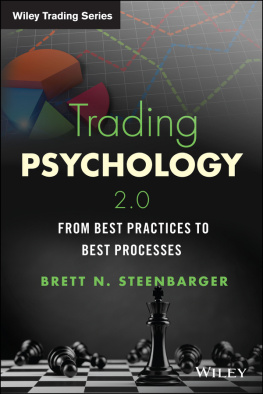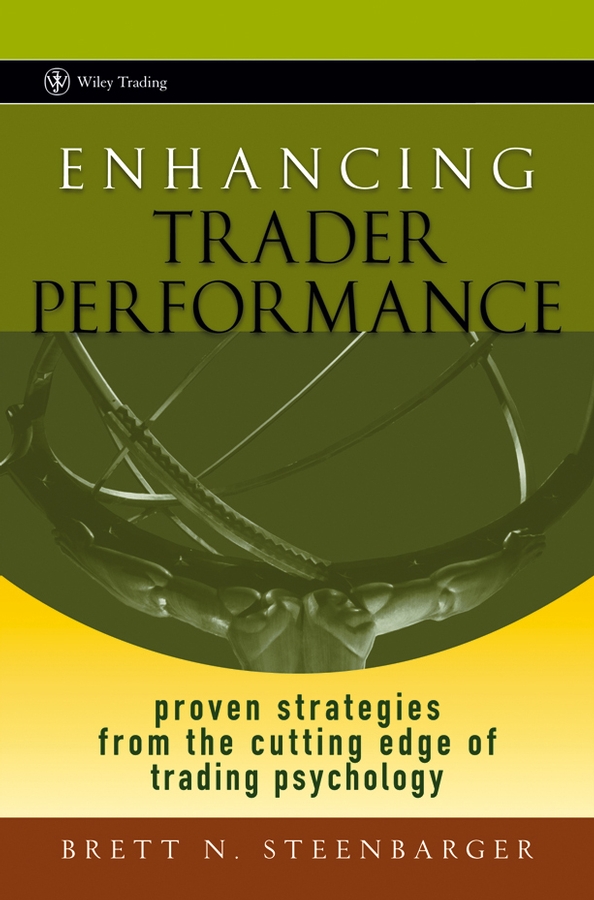Contents

Founded in 1807, John Wiley & Sons is the oldest independent publishing company in the United States. With offices in North America, Europe, Australia and Asia, Wiley is globally committed to developing and marketing print and electronic products and services for our customers professional and personal knowledge and understanding.
The Wiley Trading series features books by traders who have survived the markets ever-changing temperament and have prosperedsome by reinventing systems, others by getting back to basics. Whether a novice trader, professional or somewhere in-between, these books will provide the advice and strategies needed to prosper today and well into the future.
For a list of available titles, please visit our Web site at www.WileyFinance.com
Copyright 2007 by Brett N. Steenbarger. All rights reserved.
Published by John Wiley & Sons, Inc., Hoboken, New Jersey.
Published simultaneously in Canada.
No part of this publication may be reproduced, stored in a retrieval system, or transmitted in any form or by any means, electronic, mechanical, photocopying, recording, scanning, or otherwise, except as permitted under Section 107 or 108 of the 1976 United States Copyright Act, without either the prior written permission of the Publisher, or authorization through payment of the appropriate per-copy fee to the Copyright Clearance Center, Inc., 222 Rosewood Drive, Danvers, MA 01923, (978) 7508400, fax (978) 6468600, or on the web at www.copyright.com . Requests to the Publisher for permission should be addressed to the Permissions Department, John Wiley & Sons, Inc., 111 River Street, Hoboken, NJ 07030, (201) 7486011, fax (201) 7486008, or online at http://www.wiley.com/go/permissions .
Limit of Liability/Disclaimer of Warranty: While the publisher and author have used their best efforts in preparing this book, they make no representations or warranties with respect to the accuracy or completeness of the contents of this book and specifically disclaim any implied warranties of merchantability or fitness for a particular purpose. No warranty may be created or extended by sales representatives or written sales materials. The advice and strategies contained herein may not be suitable for your situation. You should consult with a professional where appropriate. Neither the publisher nor author shall be liable for any loss of profit or any other commercial damages, including but not limited to special, incidental, consequential, or other damages.
For general information on our other products and services or for technical support, please contact our Customer Care Department within the United States at (800) 7622974, outside the United States at (317) 5723993 or fax (317) 5724002.
Wiley also publishes its books in a variety of electronic formats. Some content that appears in print may not be available in electronic books. For more information about Wiley products, visit our web site at www.wiley.com .
Steenbarger, Brett N.
Enhancing trader performance : proven strategies from the cutting edge of trading psychology/Brett N. Steenbarger.
P. cm.(Wiley trading series)
Includes bibliographical references.
ISBN-13: 9780-470038666 (cloth)
ISBN-10: 0470038667 (cloth)
1. StocksPsychological aspects. 2. SpeculationPsychological aspects.
3. InvestmentsPsychological aspects. 4. StockbrokersPsychological aspects.
I. Title. II. Series.
HG6041.S758 2007
332.6401'9dc22
2006013294
For Margie, my partner in unchanging youth
To hold an unchanging youth is to reach at the end, the vision with which one started.
Ayn Rand
Introduction
The greater the difficulty the more glory in surmounting it. Skillful pilots gain their reputation from storms and tempests.
Epictetus
This is a book forged from storms and tempests. Roughly one year after the publication of The Psychology of Trading , I left the protected world of academic medicine to tackle the rough-and-tumble world of proprietary trading in Chicago. Gone were orderly therapy sessions in my Syracuse office. Now my day started at 4:05 A.M. and proceeded into evenings: a steady blur of tracking overseas markets, updating research, commuting into the city, moving from office to office to help traders as they traded, and then returning home to prepare for the next trading session. If The Psychology of Trading was my view from the ivory towermy integration of academic psychology and practical trading Enhancing Trader Performance is my perspective from the trenches. And quite a view it has been...
THE WINDING PATH FROM TRADING PSYCHOLOGY TO TRADER PERFORMANCE
So much has happened since late 2002, when I sat in the food court of Wegmans grocery finishing my book, plunking away at my laptop, sipping my coffee. My e-mail inbox is fuller than it was back thenit stands at 432 as I writeand Ive encountered traders from just about every conceivable setting and market. My personal web site and research blog register thousands of hits weekly, including a surprising number from Europe, Asia, and the Pacific Rim. Each day, I hear of the hopes, dreams, frustrations, and hurdles of traders around the world. Such is the privilegeand the challengeof work in the trenches.
Nothing, however, could have fully prepared me for the frontline exposure I faced at Kingstree Trading, LLC, in Chicago. No longer was I merely talking with traders about trading. Now I was in the trading, live, real-time. It is one thing to talk about what to do when a trader is caught in adverse market movement with a thousand-lot on. It is quite another to work with someone while that thousand-lot is veering into the red at $12,500 a tick. Day after day on those front lines, you learn a lot about trading and traders. You also learn quite a bit about yourself.
This book reflects that learning.
Every worthy book is like a symphony: It is held together by a theme that it explores and develops. One of my great joys as a writer is that The Psychology of Trading continues to sell as well today as it did when it first hit the bookshelves. I believe this is because its central themethat the emotional problems faced by traders are extensions of the same problems we all face in dealing with lifes risks and uncertaintieswas both unique and empowering, transcending the simplistic advice too often associated with trading psychology.
I did not want to write another book until I had one that embodied an equally promising theme. For those of us devoted to writing, a book is something precious. It is an opportunity to communicate with the many peoplepresent and futurethat we will never be able to meet. There is very little of permanence that we leave behind when we depart this earth. Books, even more than wealth or kin, have the potential to outlive us, to make their mark on those yet unborn. When youre an author, you dont want to squander that opportunity: You want to do it right.
And yet, writing a book is like living a life. You start with a set of plans neatly outlined in your head, only to look back later and wonder how you could have possibly gotten to this point. Edges of leaves, contours of clouds, hills, and plainsthere are very few straight lines in nature. Nature is jagged and rough, bent and twisted. She may not be neat, but shes real. Real like a life lived. Real like words flowing from an authors hand. The best we can hope for, in books as in life, is that weve been faithful to our themes, that weve followed their twists and turns with integrity.


